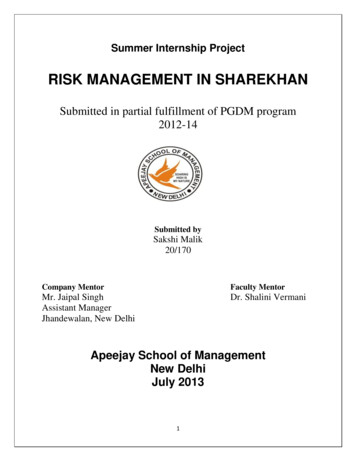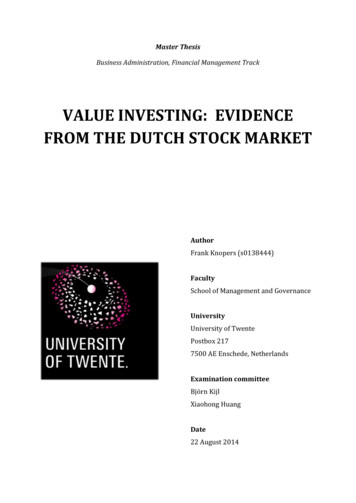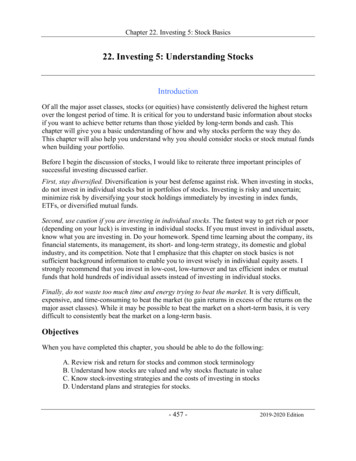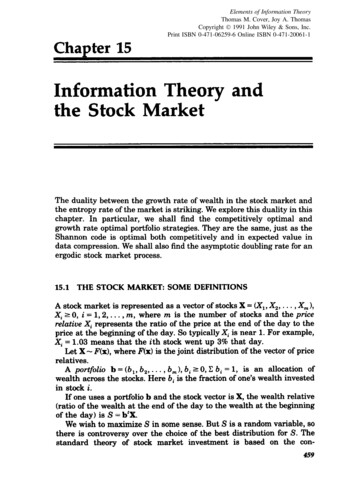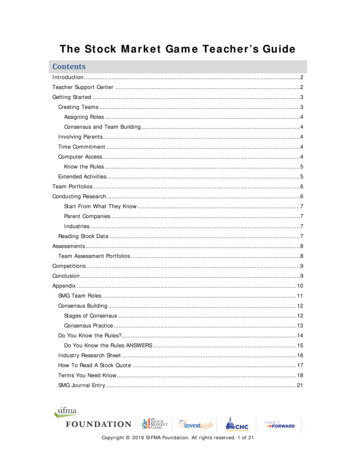
Transcription
The Stock Market Game Teacher’s GuideContentsIntroduction.2Teacher Support Center .2Getting Started .3Creating Teams .3Assigning Roles .4Consensus and Team Building .4Involving Parents .4Time Commitment .4Computer Access .4Know the Rules .5Extended Activities.5Team Portfolios.6Conducting Research.6Start From What They Know .7Parent Companies .7Industries .7Reading Stock Data .7Assessments .8Team Assessment Portfolios .8Competitions .9Conclusion .9Appendix . 10SMG Team Roles . 11Consensus Building . 12Stages of Consensus . 12Consensus Practice . 13Do You Know the Rules? . 14Do You Know the Rules ANSWERS . 15Industry Research Sheet . 16How To Read A Stock Quote . 17Terms You Need Know . 18SMG Journal Entry . 21Copyright 2016 SIFMA Foundation. All rights reserved. 1 of 21
IntroductionYou are an SMG Advisor.Similar to a real world financial advisor, your role in The Stock Market Game (SMG) is to provideyour student teams with foundational information and access to resources that help them growtheir investment portfolios.The purpose of this Teacher’s Guide is to provide you with an effective desk reference forunderstanding and navigating the SMG program and its online Teacher Support Center. Thisguide addresses the most commonly asked questions about the SMG program -- Where do Istart? What do I need? How much time does it take?This guide also addresses commonly asked questions about the Teacher Support Center – What’sin the Teacher Support Center? How do I find the right lesson? Who should I contact foradditional help?Teacher Support CenterFull access to the Teacher Support Center is available only to teachers with teams registered inthe current semester of the SMG program. The Teacher Support Center is a searchable onlinedatabase of classroom lesson plans, technical guides, projects, and other teaching resources. Itsgoal is to provide teachers with the best documentation and resources for implementing the SMGprogram in theirclassrooms.SMG lessons andactivities support thecreation andmanagement of anonline investmentportfolio, whileproviding real worldopportunities forstudents to apply andextend contentknowledge and skills insubjects like math,English Language Arts,economics, socialstudies, business,technology, personalfinance, and FamilyConsumer Sciences.Copyright 2016 SIFMA Foundation. All rights reserved. 2 of 21
In addition to the Resource Search, teachers are provided with a Manage Your Student Portfoliossection where they can see inside their students’ team portfolios, manage their own password,access a troubleshooting document, and contact the Stock Market Game’s Help Desk through anelectronic form.Additional third-party resources can be found in the Resource Links section. Please note, theseare links to third-party commercial companies. It is recommended that teachers visit these sitesfirst before introducing them to their students to ensure that the content is appropriate.The Just Getting Started section provides teachers with comprehensive guides on successfulimplementation of the Stock Market Game program. Celebrate Your Students with customizableParticipation Certificates and prizes from The SMG Store. The SMG Store is owned and managedby a third party vendor.You are encouraged to explore each section of the site. We’ve done our best to address yourconcerns through the Teacher Support Center. However, if you do not find the answers, contactyour SMG Coordinator for assistance.Getting StartedCreating TeamsThe Stock Market Game is a collaborative project-based learning activity. Before introducing yourclass to the SMG program, organize them into teams of three to five students. We recommendsmaller groups for students unaccustomed to working collaboratively. Experienced collaboratorsmay work in groups of five.Peer collaboration and group work in the SMG program provides your students with opportunitiesto practice Common Core State Standards (CCSS) College and Career Readiness (CCR) anchors inSpeaking and Listening skills including Preparing for discussionsParaphrasing portions of textReporting and recounting on researchCopyright 2016 SIFMA Foundation. All rights reserved. 3 of 21
Analyzing main ideas from diverse media and formatsAssigning RolesAssigning roles to team members help them organize their activities and provides them with anunderstanding of what is expected of them. Assigned roles also give each team member anopportunity to participate in the learning process. In the Appendix of the guide is a table of SMGTeam Roles and a description of their associated responsibilities. If you prefer, you may createyour own roles or use a combination of the roles provided. You may also rotate roles so everystudent has the benefit of experiencing each of the selected roles.Consensus and Team BuildingConsensus and team building are skills that need to be practiced and honed like math andEnglish skills. If your students are unaccustomed to working in groups, use the consensusbuilding exercise in the Appendix to help them practice.Involving ParentsIn addition to engaging students in learning, the SMG program is also an excellent opportunity tomeaningfully involve parents in your classroom. Parents who work in the banking or financialindustry could be invited to speak to the class. Parents with an interest in the investing mightdescribe some of the resources they use in their research. Parents in professions not directlyrelated to the financial services industry might be invited to talk about the industries they work inand ponder the role that industry plays in the economy.Time CommitmentThe amount of time you spend on SMG program depends on you and your goals. Depending onhow eagerly your students engage in the activities, it may take just a few class periods beforeyour students begin discussing and entering trades.Veteran Stock Market Game teachers have found that their students easily manage the technicalaspects of the SMG program and can work on their own once they've made their first trades.Many other teachers use one or two class periods a week to introduce students to investingthrough the core lessons in the Lessons & Activities section of the Teacher Support Center.It is not necessary for students to enter trades at every meeting -- but they can. The teammeetings are opportune times for students to review stock holdings and to discuss whether tobuy, sell, or hold. Many students often do their company and stock or fund research and readingof current economic events before or after class, or these activities are integrated into classlessons.Computer AccessThe Stock Market Game is a web-based investment portfolio simulation. When your teams arenot trading, they may be on the internet conducting research. If you do not have immediate oreasy access to computers with internet access, do not let it deter you from playing The StockMarket Game.The SMG program is effective regardless of whether you have only 1 or 2 computers in a room,or weekly access to a computer lab. If you only have one computer in your class, you will need torotate teams -- giving each time to look at their portfolio, enter transactions, and/or researchCopyright 2016 SIFMA Foundation. All rights reserved. 4 of 21
stocks and mutual funds. If students have access to computers at home (or after school), askthem to research stocks and funds as homework. If time and access is still insufficient, assignone student (or parent) to enter team transactions and print out team portfolio reports.If you have regular access to a computer lab, please encourage your students to utilize otherforms of research like the business columns in the newspaper, magazines, and other printedmaterials.Know the RulesIt is important you and your teams know the Rules of Participation. As their Advisor, it is yourmost important responsibility. SMG Advisors and their teams need to understand the nationalSMG rules and their local SMG program rules (if there are any).You can view national and local Stock Market Game rules by clicking Rules of the Game in theUnderstanding SMG section of the Teacher Support Center. Your students can view the rulesfrom the Trade tab in their team portfolios.Use the "Do You Know the Rules?" quiz in the Appendix to evaluate your teams’ understanding ofthem.Extended ActivitiesThe following are suggested extended activities from teachers who have successfully used TheStock Market Game in their classrooms. You may also consider the SIFMA Foundation’sInvestWrite national essay competition and its industry volunteerism program, Invest ItForward.1. Financial publications - creating a “financial literacy” rich environment is helpful forencouraging students to continue learning about investing. Contact local brokers or bankersto see if they would donate their old issues of investment magazines and newspapers(Money, Forbes, Fortune, Value Line, Barrons, Wall Street Journal, etc.)2. Local Brokers - Contact local brokers, bankers, or financial advisors to make presentationsto your students. If the broker or banker cannot show up in the class, see if they wouldn’tmind responding in writing to prepared questions from students.3. Teams of Mutual Fund Managers - Make each team a Mutual Fund Manager. Have eachteam develop their portfolio by selecting a variety of stocks from different industries to formtheir own mutual fund. This is an excellent way to teach students about mutual funds andabout diversification within a portfolio.4. PowerPoint Presentation - As a culminating activity, have each team develop aPowerPoint presentation to present their portfolio to an audience of parents, investmentprofessionals, other classes, etc. Evaluate teams on their research, technology, andpresentation skills. (See Team Folders for suggested material for presentation.)5. "Take Stock in your own State" - Have students only select stocks from their own state or "stocks of regional interest" for their portfolio. You can find these stocks (and tickersymbols) in a local newspaper or from a broker. This is an excellent way to teach studentsabout their state geography, businesses, economics and investments. Have students presenttheir portfolios to CEOs or business leaders in the state. (See PowerPoint presentations).6. Opening Bell - Begin and end each period with the ringing of a bell (just like the real stockmarket), to indicate beginning and ending of trading time for students.7. Websites for Research - Provide each team with a website that offers stock data research(many search engines do). Have each team find out all the information they can from theCopyright 2016 SIFMA Foundation. All rights reserved. 5 of 21
8.9.10.11.12.13.website, then make a presentation to other class members. This can give students an ideaof all the research material available and how/where to find it.Client Portfolio - Have each team develop a portfolio for a "client", in the same way that abroker would do. Make up fictitious client profiles - based on different investing styles. Thisis an excellent way to teach students about diversification and the role of brokers andfinancial planners.Stock Market Skit - Have students write their own skit to role play a stock trade with abroker or a broker trying to convince a potential buyer that a particular stock would beprofitable.SMG Bingo! - Create a bingo game with stock terms. Read definitions of the terms forstudents to create a "Bingo!"Bulletin Board - Keep a classroom bulletin board with headlines and articles of economic,industry, or stock market news that can affect student team portfolios (either positively ornegatively).SMG Scavenger Hunt - Create a scavenger hunt to help familiarize students with stockmarket terminology, reading stock data in the newspaper, and local, state, and worldwideevents that affect the stock market.Stock Newscast - If your school has a daily or weekly newscast - have students makeweekly "stock reports", with the Dow Jones data, market news, top ranked teams, etc.Team PortfoliosThe SMG program’s team portfolio has the same functionality as the online trading platformsprovided by companies like Ameritrade, eTrade, Sharebuilder, etc. As an SMG Advisor, you do nothave your own team portfolio. Your SMG ID and password only provide access to the TeacherSupport Center. If you would like your own portfolio to alongside your students, please contactyour SMG Coordinator to request one.You may view your students’ portfolios through the View Rankings & Portfolios link in the ManageStudent Portfolios section of the Teacher Support Center.While you do not have access to an active trading portfolio of your own, you are encouraged tovisit the Understanding Portfolios link in the Getting Started section so you can assist yourstudents in navigating their portfolios.Conducting ResearchGood research is a key element in building and managing a successful investment portfolio.Students in the SMG program are expected to do their research before entering their first SMGtrade. Their team portfolios provide access to a variety of research tools. As soon as they login,they are presented with an Account Analyzer page, which provides them with a snapshot of theirportfolios’ performance, access to ticker lookup functionality, stock data and charts, a feed ofcurrent financial news, and company descriptions.Their SMG team portfolios also provide them with access to third-party research sites likeBloomberg, Yahoo! Finance, and Morningstar through its Outside Links section and ticker lookupand company profile information on its Account Analyzer and Enter A Trade pages.Copyright 2016 SIFMA Foundation. All rights reserved. 6 of 21
Start From What They KnowTo get students thinking about the companies they might invest in, start with what they alreadyknow. Ask your students to create a list of the products they have at home like cleaningproducts, dish soap, bath soap, laundry detergent, food items in the refrigerator or cupboard,etc. (avoid clothing or status items like cell phones). In addition to the product name, theyshould also record the company that makes the product. This information is usually found on theproduct’s label. In class, they explore where the product was bought, who makes the product,and possibly other products the company produces.Parent CompaniesAs your students create a list of companies from the products they found in their home, they willcome across companies that are not listed.This means that these companies are either privately ownedowned by another countrya subsidiary of another companya brand nameFor example, students may want to invest in the Tropicana company because it makes a lot oftheir favorite juices and drinks. However, they cannot find its ticker symbol (the one to fivecharacter set that stock exchanges use to identify companies). This is because Tropicana isowned by Pepsico (its parent company). To invest in Tropicana, they would find the ticker symbolfor Pepsico (PEP).Yahoo! Finance (http://finance.yahoo.com/) is a helpful site for looking up company information.Please note it is a third party consumer site that has a lot of advertising and contains informationyou may feel is inappropriate for your students. You should always visit this site and otherwebsites first before introducing it to your class.IndustriesTo help students narrow down their investment selections and focus their research, someteachers have found it helpful to ask their students to group their companies into industries. Anindustry is a category used to organize companies into types of services and/or productsprovided.Organizing companies into industries helps students make generalizations about the performanceof a specific company compared to companies providing similar goods or services. They will bebetter able to address questions regarding how the industry's outlook is being perceived: Is theindustry profitable? Will it continue to be? What factors will affect the industry's prospects?Use the “Industry Research Sheet” in the Appendix to help your students research companiesand their industries.Reading Stock DataThe SMG core lesson, “Identifying Ticker Symbols and Interpreting Stock Quotes”, available inthe In the Classroom section of the Teacher Support Center teaches you and your students howCopyright 2016 SIFMA Foundation. All rights reserved. 7 of 21
to read and understand stock quotes. There is also a handout included the Appendix entitled,“How to Read a Stock Quote”.AssessmentsIt is recommended that students maintain journals where they record meeting minutes, trades,track data, and build company profiles. The journals encourage students to reflect on their team’sinvestment strategies, articles they have read, and any writing they may be assigned. Thejournals are useful instruments in measuring student progress. Use the Journal Template in theAppendix as a guide.In addition to the core lessons and journals, the Teacher Support Center provides you withprojects in the Projects section that assist in evaluating a student’s application of multipleconcepts. The InvestWrite national writing competition is a project that provides students with anopportunity to apply what they have learned through the SMG program to resolving hypotheticalscenarios. You are encouraged to have all your students participate in InvestWrite.Team Assessment PortfoliosBelow are some suggestions from experienced SMG teachers for assembling an assessment andwork sample portfolio to demonstrate student progress:1. Create a brief company profile for each stock your team owns during the game. Includea summary of the company’s products, where it operates, strengths and weaknesses especially in comparison to competitors - and copies of the most recent annual incomestatement and balance sheet (obtained from the company’s annual report or othersource).2. Collect basic data about stocks in portfolio including: 52 week high and low; PE ratio;volume of trading; Beta; etc.3. Clippings about stock or mutual funds in the portfolio - these can be newspaperclippings, Internet news articles, magazine ads or articles, etc.4. Current price of each stock or mutual fund the team owns at the close of the marketeach day or week. Put information in an Excel spreadsheet and create charts for eachstock or mutual fund.5. Detailed record of any buy or sell transactions including: stock or fund name and tickersymbol, date of transaction, number of shares, price per share, total costs, broker’s fees,and current equity. (Justify calculations in portfolio.)6. Create your own math problems using information in the portfolio.7. Compare data by charting your team holdings with the S&P or Dow Jones averages.8. Create a glossary of terms learned throughout the SMG program.9. Use SMG program activities as writing prompts journals. Using persuasive writing skills,students can cite their research and “persuade” team to buy or sell certain stocks ormutual funds.10. Using reflective writing skills, students can reflect on why a stock or fund did or didn’t dowell, why they disagree with a team’s decision, why and how the economy is affectingtheir stock or particular industry, etc.11. Describe a current event and the economic environment that could affect investmentdecisions.Copyright 2016 SIFMA Foundation. All rights reserved. 8 of 21
12. Write an essay explaining an investment strategy and why it was successful or was notsuccessful.Additional assessment tools like pre- and post tests and writing rubrics are available in theAssessments link in the In the Classroom section of the Teacher Support Center.CompetitionsMost local SMG programs offer a “portfolio equity” competition. In this competition, teams areranked based on portfolio equity. The team with the highest equity at the end of the tradingsession is recognized as being the winner of The Stock Market Game. The rules and awards forthis competition differ from location to location. Contact your local SMG coordinator forinformation about your local SMG portfolio equity competition.Some SMG programs offer a “percent return” competition instead of a portfolio equitycompetition. In the percent return competition, team portfolios are ranked based on theirpercentage growth as compared to the Standard & Poor’s (S&P) 500 Index. The S&P 500 consistsof 500 large companies that represent the major sectors of the US economy.Contact your local SMG coordinator for information regarding the type of portfolio competitionavailable to you.You may track the progress of your teams by clicking View Rankings & Portfolios in the ManageStudent Portfolios section of your Teacher Support Center. Your students may check their team’sprogress by clicking the Rankings icon at the bottom of their portfolio Welcome page.In addition to the portfolio equity and percent return competitions, you may register yourstudents for the InvestWrite, our national writing competition developed by teachers toencourage the application of the knowledge students have gained from their SMG experience.InvestWrite is open to all SMG Advisors with active team IDs. For more information aboutInvestWrite, click its banner on your Teacher Support Center Welcome page or visitwww.investwrite.org.ConclusionThe Stock Market Game is an educational program of the SIFMA Foundation. It is an onlinesimulation of the global capital markets that engages students (grades 4-12) in the world ofeconomics, investing and personal finance, and prepares them for financially independentfutures. Nearly 600,000 students take part every school year across all 50 states and around theglobe. The Stock Market Game has reached 13 million students since its inception in 1977.An independent study funded by FINRA, the securities industry’s largest independent regulator,found The Stock Market Game had a positive impact on student math achievement and financialliteracy. It also found that the SMG program influenced the investment decisions of the teacherswho taught it.Recent history has taught us just how important it is to have a fundamental understanding ofsaving and investing. The Stock Market Game has significant and measurable impact on studentfinancial literacy and academic achievement across all grades.Copyright 2016 SIFMA Foundation. All rights reserved. 9 of 21
AppendixThese are supplemental materials for your SMG program. They appear in the order that theywere mentioned.1.2.3.4.5.6.7.SMG Team RolesConsensus BuildingDo You Know the Rules?Industry Research SheetHow to Read a Stock QuoteTerms You Should KnowJournal TemplateCopyright 2016 SIFMA Foundation. All rights reserved. 10 of 21
SMG Team RolesCOORDINATORRESEARCHERREPORTERDIRECTORThe Director is in charge of the team. It is his responsibility to coordinatethe efforts of entire team and ensure that activities are being completedsuccessfully and that everyone on the team is being treated fairly. If theoccasion arises, he is responsible for summarizing his team’s activities andreporting them to the teacher and other teams.DIRECTOREveryone on the team is responsible for gathering and sharing research onpotential investments and trades. The Lead Researcher is responsible forcoordinating all of his teammate’s findings and summarizing them.LEADRESEARCHERLEAD PORTFOLIOCOORDINATORLEAD DATA ENTRYCOORDINATORLEAD REPORTERThe Lead Portfolio Coordinator may not have much to do at first but a weekinto the game, he will be busy monitoring his team’s portfolio transactions.He keeps a record of all transactions made by his team to verify portfoliodata being displayed is correct. He reviews his team portfolio’s TransactionHistory, Account Summary, Account Holdings, and Gains & Losses reportsfor accuracy.All of the team members should have a chance to logon and enter trades.The Lead Data Entry Coordinator is responsible for the transactions enteredinto his team’s portfolio. He checks their portfolio’s Pending Transactionsand Transaction Notes sections for error messages.The Lead Reporter is in charge of compiling his team members’ meetingnotes. His job is to maintain a current journal of his team’s activities andthe status of their portfolio.Copyright 2016 SIFMA Foundation. All rights reserved. 11 of 21
Consensus BuildingBuilding consensus means coming to an agreement about something. You will be buildingconsensus when you come together as a team to decide which stocks, bonds, and mutual fundsyou wish to include in your portfolio.2. CONTRIBUTE4. EVALUATEObservation of both verbal andnon-verbal signs from teammembers will help determinewhen consensus has occurred.In many cases a formal vote onan issue is not necessary.Determine what points teammembers agree on and what pointsthey disagree on. Spend timeevaluating the differences.6. VIEWDon’t waste time discussingthose points that team membersalready agree on.Share all relevant information evenif it conflicts with personal interests.Conflict about ideas, solutions,rationales, and predictions helpsensure that all sides of an issue areexplored to the satisfaction of allteam members.8. COMPROMISE3. INCLUSIONEnsure that everyone is includedin the decision-making process.5. TIMEBe sure that each team memberhas a full understanding of whatother team members are saying.7. LOOK1. LISTENStages of ConsensusIt doesn’t mean that a teammember gives up a position. Itmeans that the opinions of all teammembers are equally important,that each member will discuss anissue with an open mind, and iswilling to fully support a decisionmade by the entire team.Copyright 2016 SIFMA Foundation. All rights reserved. 12 of 21
Consensus PracticeLet’s practice consensus building by agreeing on a name for your Stock Market Game team.First:BRAINSTORMEveryone on the team creates a list of names. Don’t thinktoo much about it, just get all the ideas you can on paper asfast as you can.Second:EVALUATEEach team member chooses their top two choices fornames and provides a reason why they are good names.Third:DISCUSSThe team Director asks each person to give a reason whyparticular name is a good name and why that same namemight not be a good name.Fourth:DECIDEAfter discussing the pros and cons of the names the teamvotes on a name, if a consensus has not yet been reached.Copyright 2016 SIFMA Foundation. All rights reserved. 13 of 21
Do You Know the Rules?Please answer the following questions in complete sentences. Be sure to cite the rule thatsupports your answer.1. Excluding interest earned, how much cash does each team begin The
market terminology, reading stock data in the newspaper, and local, state, and worldwide events that affect the stock market. 13. Stock Newscast - If your school has a daily or weekly newscast - have students make weekly "stock reports", with the Dow Jones data, mar

